Welcome to the fascinating world of insects, some of the most successful creatures on Earth. Scientists have identified an estimated 750,000 different types of insects, showcasing their incredible diversity. In Canada alone, around 55,000 insect species can be found crawling or flying around. Among all these incredible insects, there are a few that really stand out because they’re so big!
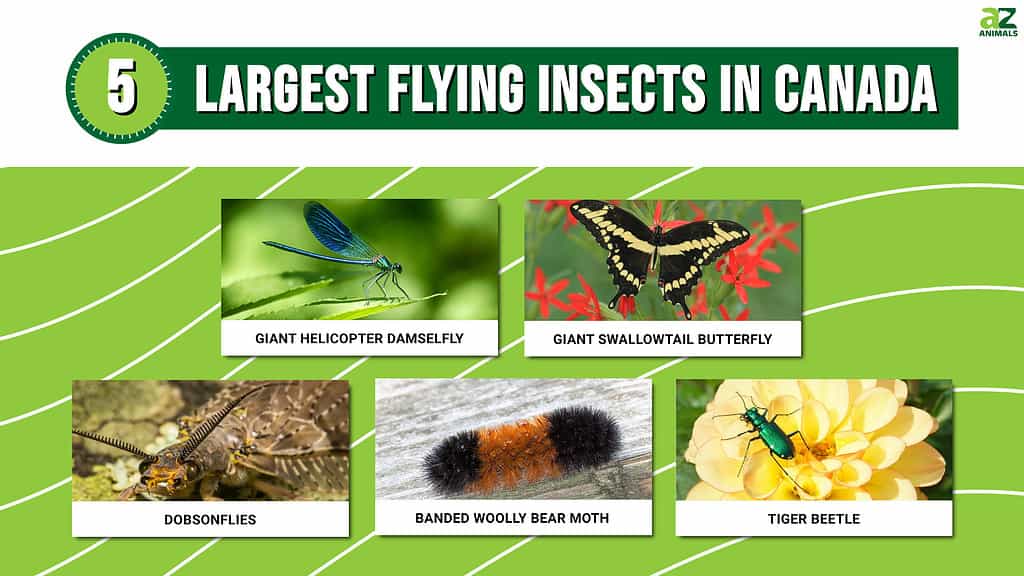
What are some of the biggest bugs you should know about? Join us as we explore the largest flying insects in Canada.
1. Giant Helicopter Damselfly — 7.48 inches
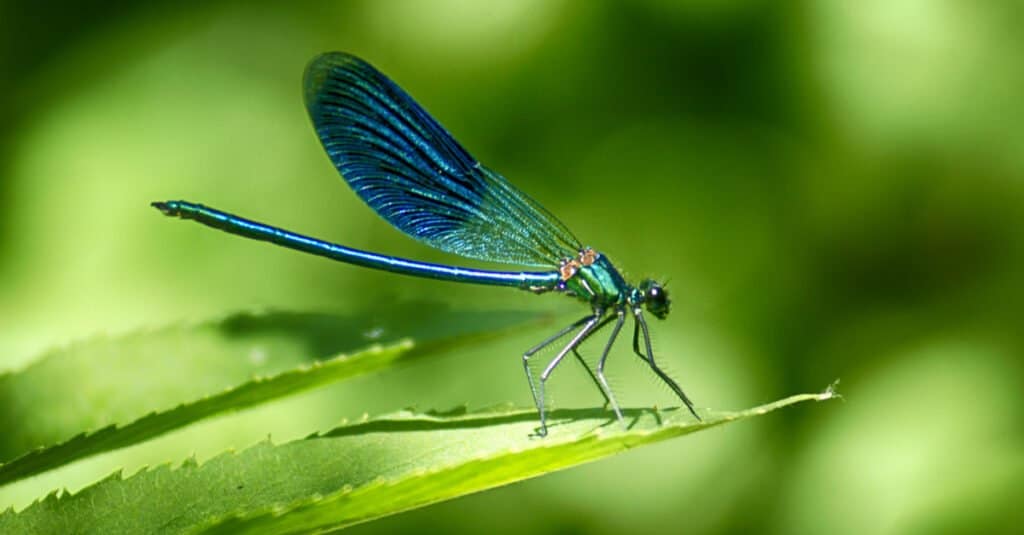
Giant damselflies have long, thin bodies and impressive wingspans that can reach 7.5 inches.
©Costea Andrea M/Shutterstock.com
The giant helicopter damselfly is the biggest kind of dragonfly or damselfly. And it loves living in Canada. This insect has a wingspan that can reach up to 19 cm or 7.48 inches. The males are bigger than the females, with bodies up to 10 cm long. They have clear wings with metallic-blue bands and white strips. They mostly eat orb-weaver spiders that they find in the forest. These damselflies are good for people, too, because they help reduce the number of mosquitoes.
Where can you spy a large damselfly? Even though it’s big, helicopter damselflies don’t fly for long times and don’t like to fly over large clearings. Instead, helicopter damselflies like wet and moist forests with lots of rain.
The males look for large holes in trees, which they use for breeding. The females then lay their eggs in these water-filled holes. The eggs hatch into young damselflies called naiads. These naiads live in the water, eating larvae in the tree hole. After about 40 days, they change into adult damselflies.
Giant Swallowtail Butterfly — 5.8 inches
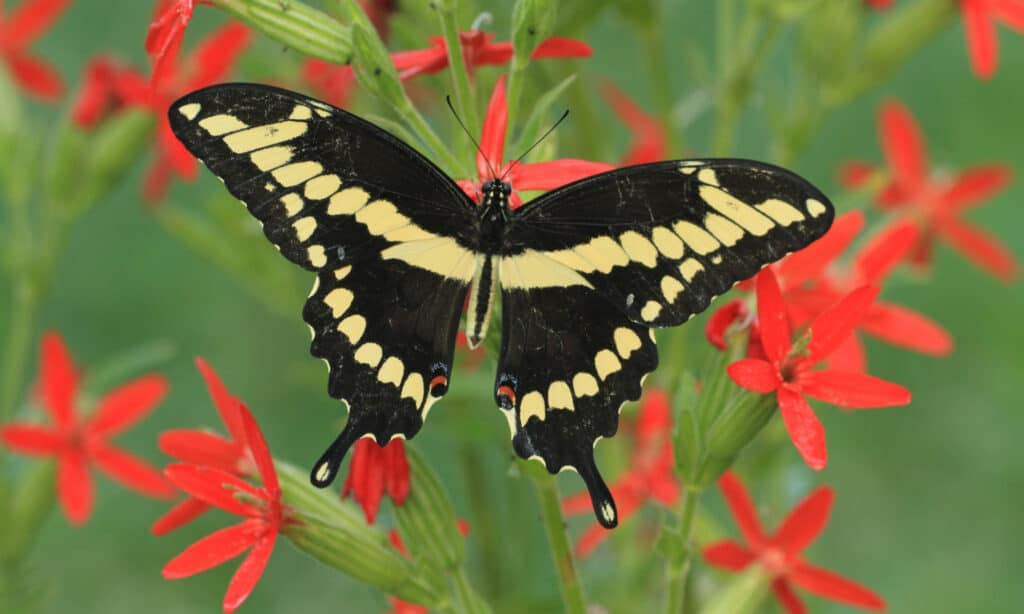
With a wingspan that can surpass 5 inches, giant swallowtails are humongous butterflies.
©Kevin Collison/Shutterstock.com
Giant swallowtails are big butterflies in Canada whose wingspan can easily surpass 5 inches. Males can have a wingspan of about 14 cm and females about 14.7 cm. Their wings are black with a yellow bar on the front wings, and the underside is mostly yellow. They have yellow-filled tails and a small red patch on the back wings. Over the years, giant swallowtails have been getting used to colder temperatures in the north.
These butterflies love to feed on nectar from flowers. Female butterflies lay their eggs on leaves. The eggs are cream to brown and look a bit like orange peel. Once born, the caterpillars stay safe by mostly eating at night. They munch on plants like sweet orange trees, northern prickly ash, and Hercules club. These plants are very important for the butterfly population.
Camouflage is another way they stay safe from predators. The tiny caterpillars look like bird droppings, and older caterpillars can look like small snakes. The caterpillars also have a special gland that lets out a foul odor to deter would-be predators.
3. Dobsonflies — 5 Inches
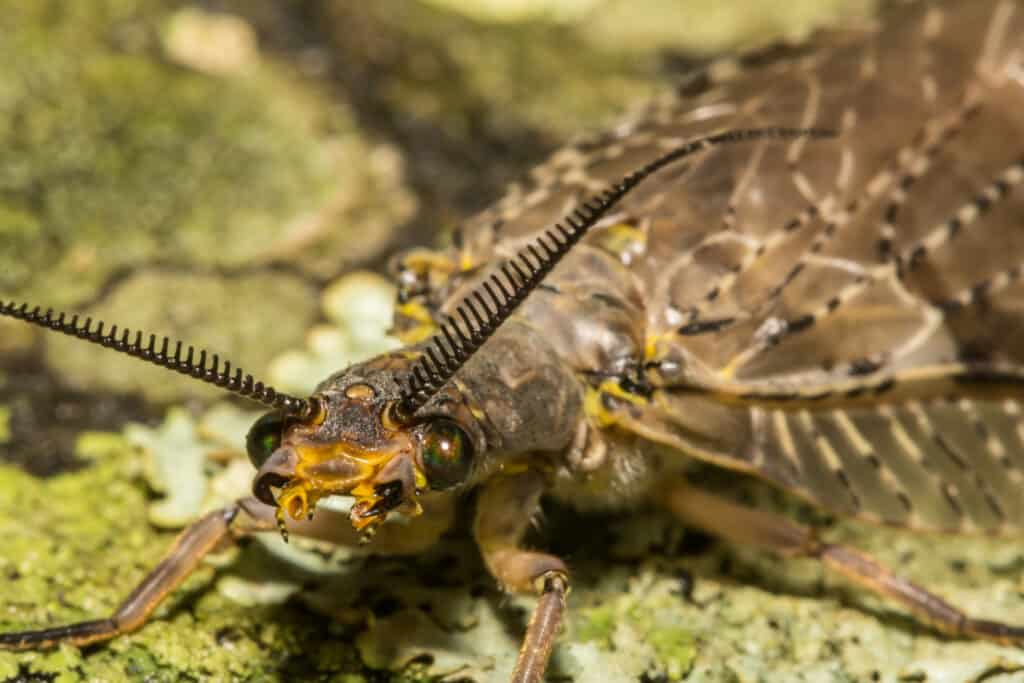
Dobsinflies can grow to be 5 inches long.
©iStock.com/JasonOndreicka
Dobsonflies are large and freaky-looking insects, with males and females reaching impressive lengths of up to 5 inches. Males possess pincer-like mandibles, while females sport shorter and stouter mandibles. Their wings are densely lined with intersecting veins and are folded parallel to the body at rest.
Dobsonflies also have long, segmented antennae and three eyes. Along with their intimidating appearance, dobsonflies also possess a stinky anal spray that they use as a defense mechanism.
Where can you see dobsonflies in Canada? These insects are primarily nocturnal and commonly found near bodies of water. They’re most active from late spring to mid-summer and are often attracted to lights. The larvae, known as hellgrammites, are aquatic. They survive in rapidly flowing water by resting under rocks and debris.
The larvae of dobsonflies are predatory. That means they prey on other organisms in the water to survive. However, adult dobsonflies do not feed, and they have a very short lifespan. Males live about three days and females more than triple that amount, living up to 10 days.
4. Banded Woolly Bear Moth — 2.25 inches
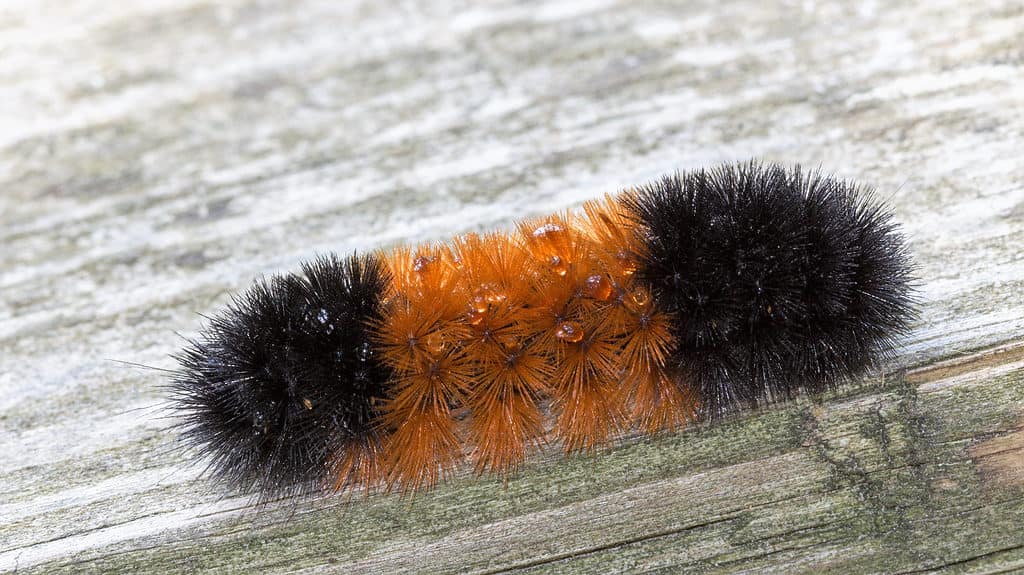
Folklore says the colors of the woolly bear caterpillar can predict the severity of an upcoming winter.
©Kimberly Boyles/Shutterstock.com
The banded woolly bear, also known as the woolly bear or woolly worm, is a well-known insect in Canada. This insect has a wingspan ranging from 1¾ to 2¼ inches. Folklore says that before the caterpillar transforms into a butterfly, it holds special weather-predicting powers.
According to this folklore, the coloring of the caterpillar can provide insight into the severity of the upcoming winter. Legend has it that a wider reddish-brown band on the woolly bear caterpillar indicates a mild winter, while a narrower band suggests a harsh one.
Woolly bear caterpillars are herbivores, feeding on plants. During the fall, they seek shelter under bark, leaf litter, or logs. Sometimes they fall victim to wasps that lay eggs on them, leading to their eventual demise.
Woolly bears can overwinter inside cocoons as pupae. These overwintering caterpillars can withstand freezing temperatures thanks to their cozy cocoons made from their own hairs.
When the next generation of moths emerges from their cocoons, they mate and lay eggs. Some of their favorite spots to lay eggs include trees and grass.
Males moths have a light, yellowish-brown shade with small black spots, while females showcase beautiful pink wings. The adults have a relatively short lifespan and are preyed upon by various predators, including spiders and bats.
5. Tiger Beetle — 0.35 to 0.83 inches

There are over 30 species of
tiger
beetles in Canada, and some can grow to be nearly an inch long.
©iStock.com/Christiane Godin
Tiger beetles are remarkable insects with large eyes, thin bodies, and big mandibles. They range from 9 mm to 21 mm in length. Their coloration varies from metallic green, blue, and purple to light tan or dull brown. The beetles’ distinctive markings on their wing covers add to their one-of-a-kind appearance.
Equipped with long legs, these beetles are known for their swift movements, which aid in hunting. But going fast isn’t always an advantage. Sometimes top speeds momentarily blind them.
Over 30 species of tiger beetles exist in Canada, demonstrating the diversity of this predatory insect group. Despite their ferocity in the wild, they do not usually invade homes. However, they may accidentally enter or be brought in by hikers.
Gibson’s Big Sand Tiger Beetle
Gibson’s big sand tiger beetle is a striking species of tiger beetle that measures between 14 to 21 mm in length. Its distinguishing feature is a dark red to purple stripe set against a light ivory color. This beetle, has six legs, a long antennae, and powerful mandibles. This stunning beetle follows a complete metamorphosis life cycle, transitioning through egg, larval, pupal, and adult stages.
Gibson’s big sand tiger beetle hunts on foot but can take flight when threatened. This species faces predators such as robber flies, lizards, birds, and large groups of ants. Their preferred habitat includes active dunes found in localized regions of southern Saskatchewan and possibly southeastern Alberta. Unfortunately, they’re currently threatened due to habitat loss and invasive plants, leading to its recent listing under the Species at Risk Act.
A crucial discovery in recent years revealed that this threatened beetle is really two genetically distinct subspecies. This finding has big implications for conservation efforts, stressing that both populations are more endangered than previously believed.
Northern Barren Tiger Beetle
The northern barren tiger beetle, measuring 13-14 mm long, is a bright green insect. These beetles primarily feed on small insects and arthropods. Ants are a big part of their diet. Like other tiger beetles, they rely on their eyesight and speed to take down prey.
Their hunting strategy is a blend of pursuit and ambush. And the larvae also hunt and feed. They’ll lie in wait in their burrows to capture unsuspecting prey with their big mandibles.
Summary of 5 of the Largest Flying Insects in Canada
| Rank | Insect | Size |
|---|---|---|
| 1 | Giant Helicopter Damselfly | Wingspan: Approximately 7.5 inches |
| 2 | Giant Swallowtail Butterfly | Wingspan: 5.8 inches (females), 5.5 inches (males) |
| 3 | Dobsonflies | Length: Up to 5 inches |
| 4 | Banded Woolly Bear Moth | Wingspan: 1¾ to 2¼ inches |
| 5 | Tiger Beetle | Length: 0.55 to 0.83 inches |
The photo featured at the top of this post is © Jay Ondreicka/Shutterstock.com
Thank you for reading! Have some feedback for us? Contact the AZ Animals editorial team.







